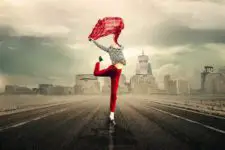There are many obstacles in the path of a dedicated author. Writer’s block is the most famous – that seemingly unbreakable stasis in which some authors find themselves unable to pen a single constructive word – but it’s not the only one. Another, perhaps more common, is being able to write but simply not knowing what happens next.
Not knowing what happens next can strike at any time. You might be a planner, unable to finish the timeline that illustrates how your story will progress, you might be a ‘pantser’ who’s already written twenty chapters and now doesn’t know what shape twenty-one should take, or you might be somewhere between the two, suddenly realizing that the ending you’d always intended suddenly just doesn’t work.
Sometimes, the ending you intended just doesn’t feel right. So… what happens next?Click To TweetIt’s a freaky experience to suddenly realize that your story has gotten away from you, but it’s one you can work through with just one question. That’s the question I’ll be revealing in today’s article. First, though, how can it be so hard to figure out what happens next?
Intuition
To non-writers, the idea of not knowing what happens next can seem bizarre. After all, you’re in complete control of the characters, not to mention the world around them and every event they encounter. Surely any author worth their salt can just… keep writing?
In some ways, this is true. If you were forced at gunpoint to simply relate a series of events, you could absolutely keep going with anything that came to mind. But, as we’ve discussed before, authors don’t write just to write, they write to be read, and that means the rules are very different.
Suddenly, it’s not simply about forcing events to progress, it’s about finding the ‘correct’ path to follow. That path is defined by a lot of criteria, including:
- What feels consistent with prior characterization,
- What makes good use of the imagery, themes, and patterns you’ve sown throughout your story,
- What pays off the specific emotional and intellectual investments the reader has made in the story so far.
In many ways, completing a story means fathoming patterns you weren’t fully conscious you’d begun. There is, in this sense, a ‘right’ answer, even if it’s one of several, and even if the only way to know you’ve found it is that it feels right to you. That ‘feeling’ is valuable because it’s an instinctual understanding of what works based on your intimate appreciation of your own work.
The good news is that this changes the nature of the question you need to ask. Now, we know that you’re not searching for some indefinable answer that could be anything. In fact, a two-step process suggests itself:
- Identify the criteria that define what your story needs to do next,
- Identify what possible events fit those criteria.
That’s not to say that things are suddenly simple. Identifying those key criteria is still difficult, and presenting the authorial part of your brain with potential scenarios, waiting for that ping of intuition, is probably still the best way to go.
Authors understand their stories on an instinctual level. If it doesn’t ‘feel’ right, it probably isn’t.Click To TweetIn the interest of doing so, let’s turn to a Pixar storyboard artist and literature’s greatest detective.
Just keep swimming
So, you’ve waited long enough, what’s the single question that will help you figure out what happens next in your story?
What doesn’t happen next?
It’s a question that seems ludicrous if you believe an author can just write whatever they like, but we know better. Instead, the point is to define your crucial criteria by seeing what they forbid. It’s a technique described by Pixar storyboard artist Emma Coats.
When you’re stuck, make a list of what WOULDN’T happen next. Lots of times the material to get you unstuck will show up.
– Emma Coats, ‘The 22 rules of storytelling, according to Pixar’
The idea isn’t to simply think up everything that wouldn’t happen, but to present yourself with a list of narrative impossibilities and appraise why each is unworkable. In this way, you engage in a process of describing the existing patterns and needs of your story, and that helps you define what does work. Or, as Sherlock Holmes would have it:
When you have eliminated the impossible, whatever remains, however improbable, must be the truth.
– Sir Arthur Conan Doyle
In this case, ‘impossible’ isn’t meant literally, but rather in relation to the mechanics of your story. Whatever doesn’t work can’t be used, so it’s impossible. Whatever isn’t dismissed on those grounds (that is, whatever meets the standards of your intuition) is possible, and however strange of an idea it seems, it’s worth considering.
This is an important thing to keep in mind because in those case where it’s hard to figure out what should happen next, the answer often comes out of left field. One common example is the author who leaves their group of protagonists in the villain’s clutches and then has no idea how they all escape.
Do they simply run away? No, the villain’s henchmen are too numerous for that to feel right. Did they set up their escape before being captured? No, they’re the underdogs, and they don’t have the resources. Does help arrive from an unexpected place? Perhaps, but that means the same thing can’t happen later, when it’s far more key to the story. So perhaps… they don’t all get away. Maybe what ends up feeling right, what gels with a cast of underdogs fighting against a powerful antagonist, is losing a cast member. In fact, maybe that really likable character – the one who the reader in you wants to survive – can meet their maker without hurting the narrative.
Asking ‘what DOESN’T happen next?’ might be the key that unlocks your story.Click To TweetThese are the kinds of revelations you’ll often discover when you ask ‘what doesn’t happen next?’, but they’re the kind of revelations that emerge from realizing what your story has always been about.
The practical approach
Of course, this is all theory, and the practical application is far more important. To that end, a great place to start is with Coats’ instruction to write a list. It’s a good idea to try and detach yourself from critical thinking before you begin. Simply write down everything that could plausibly happen next in your story. Here, I’m not talking from an outside, mechanical, authorial viewpoint, but rather in the world of the story you’re telling.
Write a list of every possible outcome of the situation you’re stuck on, large or small, until you can’t think of any more. Go for a run, have a shower, eat lunch, and then return to the list, just in case the time away has shaken loose a few more possibilities.
Once that’s done, turn your critical thinking back on. Go down the list, first searching out your intuitive reaction and then working through it logically, figuring out why you’re dismissing a potential option. Create a parallel list of your reasoning, and use this to narrow down what you actually need from what comes next.
Rejecting potential outcomes to your story could be how you discover its ideal form.Click To TweetFinally, be sure that you’re actually letting your intuition have its turn. Finding an answer inconvenient because it necessitates rewriting isn’t the same as truly believing it won’t work. Sometimes, the answer to ‘what happens next’ is an amazing scene that means rewriting what you already have. Those are the breaks.
What doesn’t happen next?
You already know there’s no shame in hitting a brick wall, but hopefully this technique will be useful in finding your way around it. Let me know how useful you find asking ‘what doesn’t happen next?’ in the comments, and check out The Quadrant Method Is The Key To Amazing Storytelling and Why Writers Like You Need To Know Their Key Event From Their First Plot Point for insights into story structure that offer more ways to deal with this issue.






2 thoughts on “A Single Question To Help You Figure Out What Happens Next”
Some really good ideas, Robert. Thank you for sharing them with us.
I’ve used the “What wouldn’t happen next” method, but make my goal to write ten things in as much detail as possible – at least a paragraph or two per idea. Kidnapped by aliens in a historical romance? Sure. A firey death after a dance number in a mystery? Okay. The more rediclous, the better. I usually find somewhere between thing three and five, I either get an idea that would work or realize one of my rediclous ideas will work with modifications. I think for me, writing without censoring myself unsticks something and gets me back in the groove.